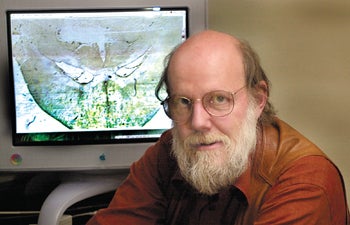
Men with Alzheimer’s gene at risk of brain bleeding
A common genetic variation that is linked to Alzheimer’s disease greatly raises the likelihood of tiny brain bleeds in some men, scientists have found.
These “microbleeds” leave small points of damage throughout the brain and contribute to memory loss.
The study reveals that the gene variant ApoE4 (short apolipoprotein E 4) for has different effects on men and women diagnosed with mild cognitive impairment or Alzheimer’s. The research further underscores the significance of ApoE4 in Alzheimer’s, building upon prior studies indicating the disease has sex-based differences that may affect treatment approaches.
“It’s important to study sex-based differences in Alzheimer’s because women live longer than men, and, as this study shows, the disease can affect them differently,” said corresponding author Caleb Finch, University Professor, professor of biological sciences, anthropology and psychology at USC Dornsife, and professor of gerontology at USC Davis School of Gerontology.
Memory loss
The finding is especially striking since prior research indicated that Alzheimer’s disease was more troublesome for women. Those with ApoE4 are almost twice as likely as men to be diagnosed with the disease. Also, women suffer worse memory loss than men for a given load of plaques and tangles of proteins — the classic Alzheimer’s markers.
USC studies have found ApoE4 can be an aggravating factor even for non-Alzheimer’s patients; ApoE4 is well-known for worsening the effects of traumatic brain injury.
The latest study, which involved research on mice and on humans, also provides new evidence that Alzheimer’s is unique to humans.
“Most diseases can be studied in lab animals without introducing human genes,” said Finch, who also holds the ARCO/William F. Kieschnick Chair in the Neurobiology of Aging. “That is not the case for Alzheimer’s.”

University Professor Caleb Finch.
Even mice and apes that have some factors or symptoms associated with the disease do not suffer the same cognitive impairments and neuron losses that Alzheimer’s patients do, the scientists noted. The likely difference that spares animals from this brain-wasting disease is that animals do not have multiple genetic variants of ApoE – a class of lipid-carrying proteins produced by the liver and the brain.
Humans have three variants, including ApoE4, the most common Alzheimer’s risk gene, while chimpanzees, their closest relative, have only one type of ApoE. The ApoE proteins transport cholesterol and other fats through the bloodstream. ApoE4 carriers tend to have higher cholesterol.
Scanning for microbleeds
Clinical scientists on Finch’s team examined brain scans of people, aged 48 to 91 years old, in the United States and Canada, who are part of the Alzheimer’s Disease Neuroimaging Initiative.
The ongoing study in the Karolinska Institute Dementia Study in Sweden analyzed scans of subjects aged 36 to 88 years old.
The researchers found that ApoE4-carrying men with mild cognitive impairment or Alzheimer’s disease suffered twice as many microbleeds in their brains as women with similar diagnoses.
Microbleeds differ from stroke in size and impact, Finch said. Stroke is a macro event that usually occurs on one side of the brain and its effect is usually immediate. Microbleeds occur anywhere in the brain over time, with cumulative effect.
The research team had also studied the effects of ApoE4 in mice, but found female mice — not males — with ApoE4 were more likely to suffer microbleeds. The female mice also were more likely to have higher brain amyloid levels (plaque) — similar to the effects that women suffer with the disease.
However, the results “did not appear to generalize to human AD (Alzheimer’s disease),” the scientists wrote.
Next steps
Based on the findings, Finch said researchers must now see if they can reduce the microbleeds using sex steroids. Because of Alzheimer’s differing effects on men and women, they may consider other changes in treatment, too.
“We may need different therapeutic strategies for ApoE4-carrying men who are Alzheimer’s patients than for women,” he said.
USC researchers in multiple disciplines are dedicated to studying Alzheimer’s, including its health, political, economic and social implications. Efforts to understand it and find new and more precise treatments are much more pressing as the baby boomer generation ages. The USC Schaeffer Center for Health Policy and Economics predicts the number of U.S. patients diagnosed with Alzheimer’s will more than double to 9.1 million in 35 years. Total care costs then will top $1.5 trillion.
Finch, who founded the USC Alzheimer Center in 1984 and has studied the disease for more than 30 years, said it’s difficult to untangle all of the factors that may contribute to Alzheimer’s disease.
“The basic cause of slow-spreading neuron death is still unknown,” he said.
The study was published online on Oct. 19 by Neurobiology of Aging.
Other authors include USC Davis scientists Mafalda Cacciottolo, Amy Christensen, Alexandra Moser, Jiahui Liu, Christian Pike and Todd Morgan; Egor Dolzhenko of the Department of Molecular and Computational Biology at USC Dornsife; Patrick Sullivan of Duke University’s Department of Medicine; Andreas Charidimou of Harvard Medical School and Massachusetts General Hospital Stroke Research Center; Lars-Olaf Wahlund, Maria Kristofferson Wiberg and Sara Shams at the Karolinska institute; and Gloria Chia-Yi Chiang at Weill Cornell Medical College.